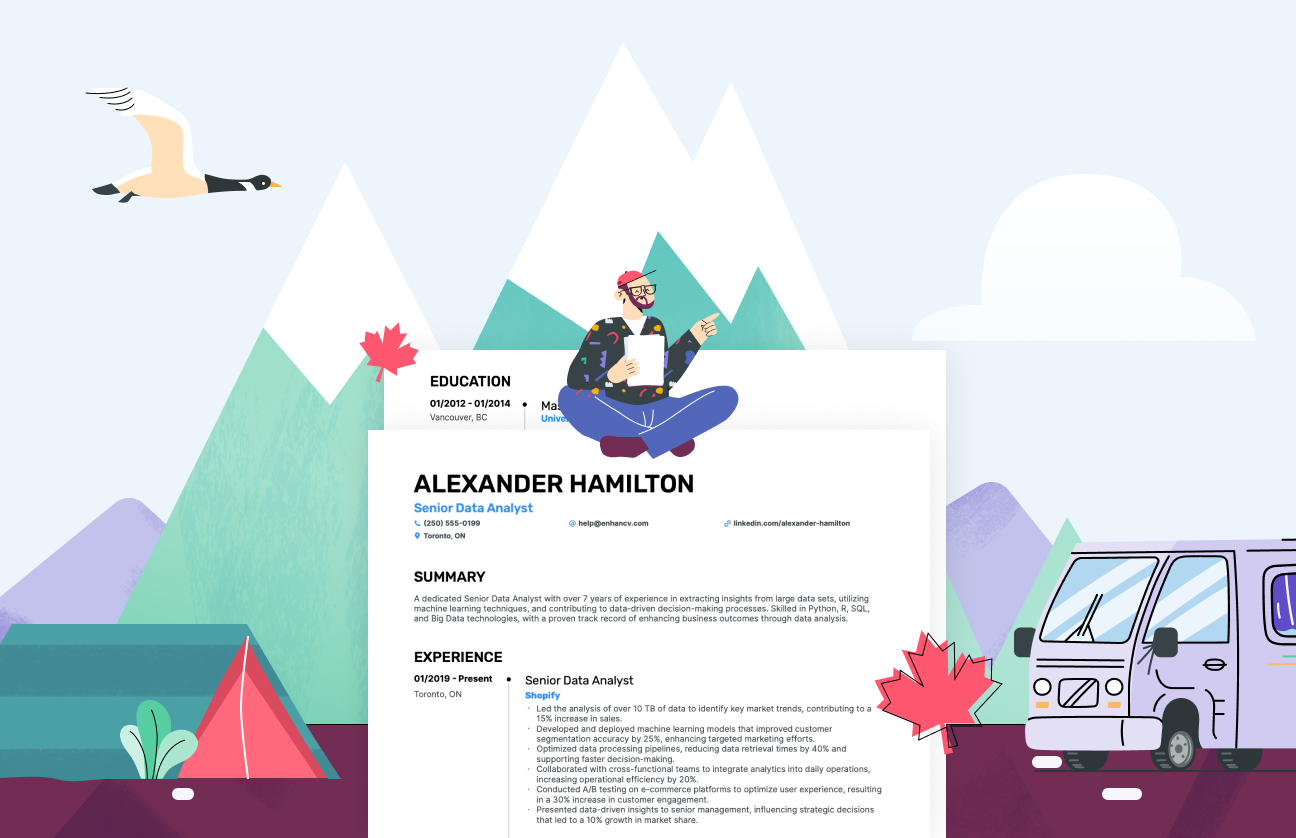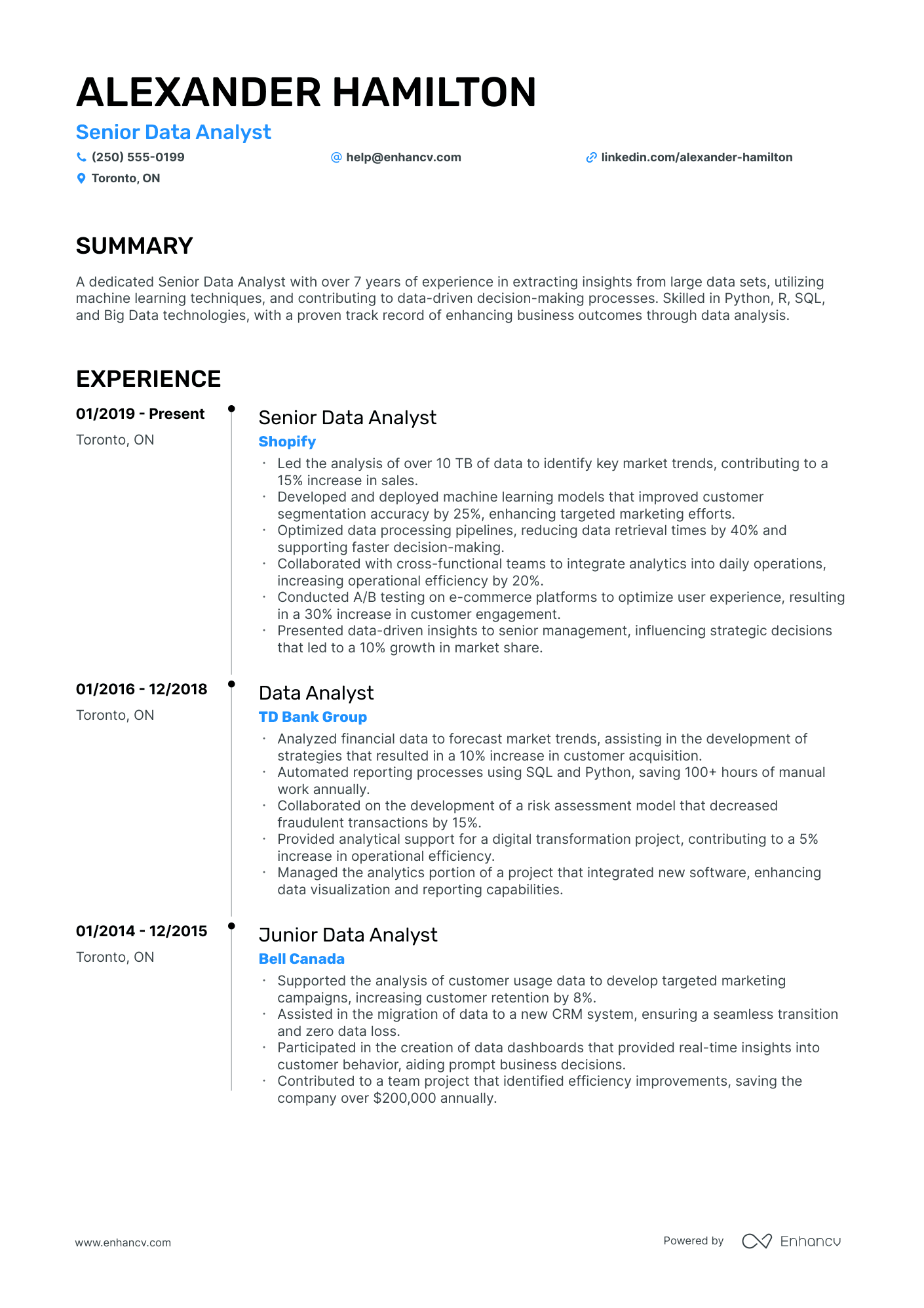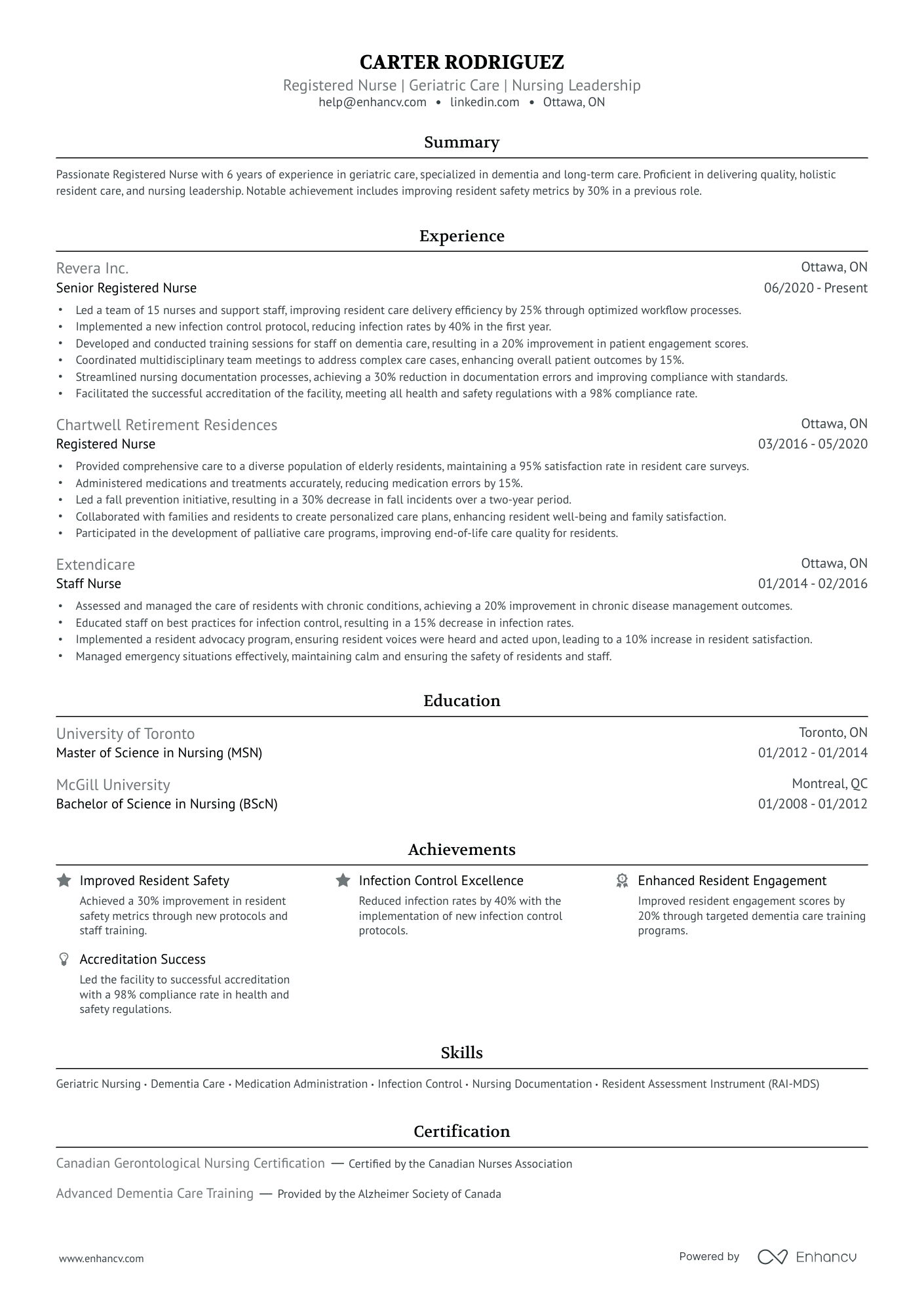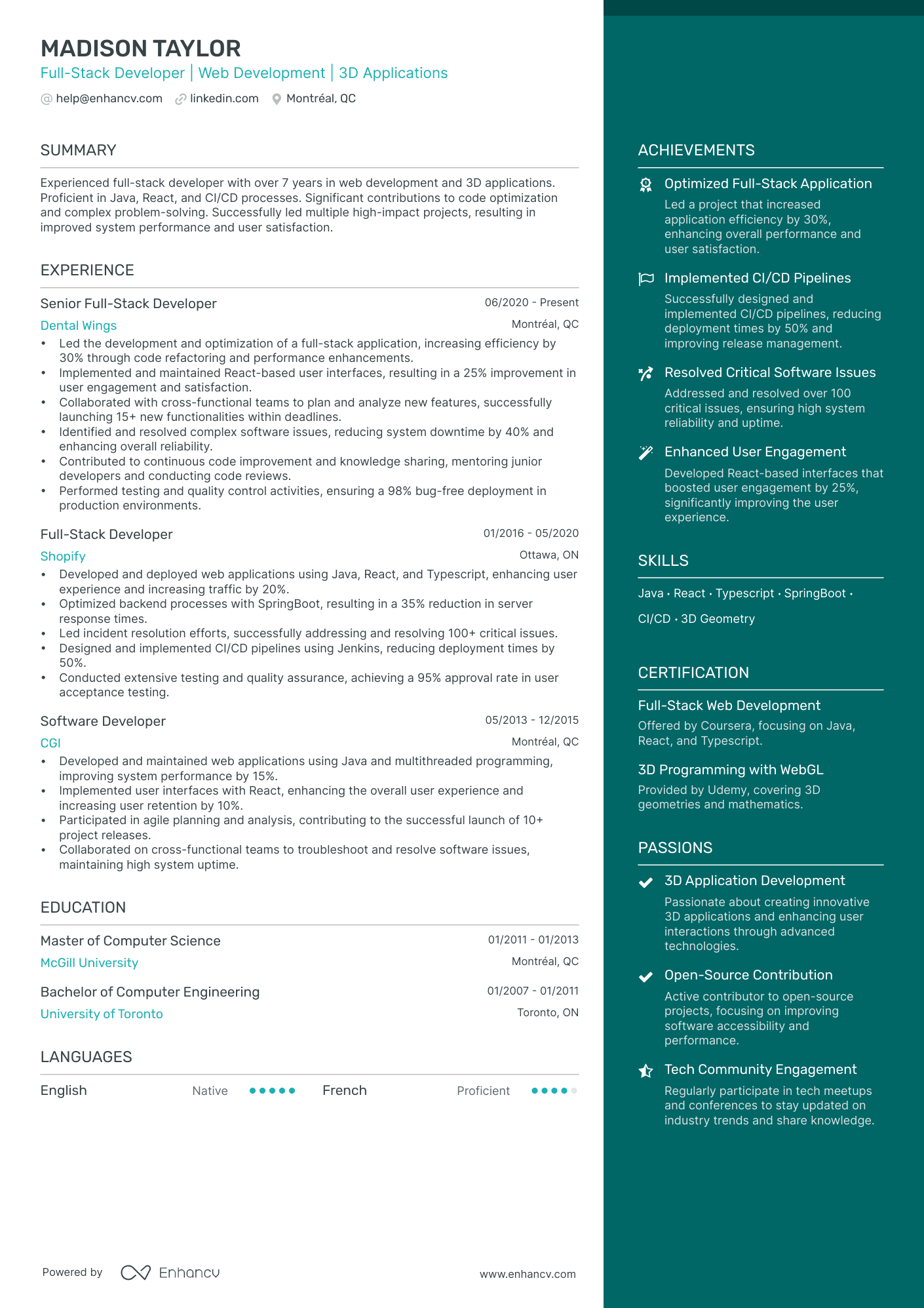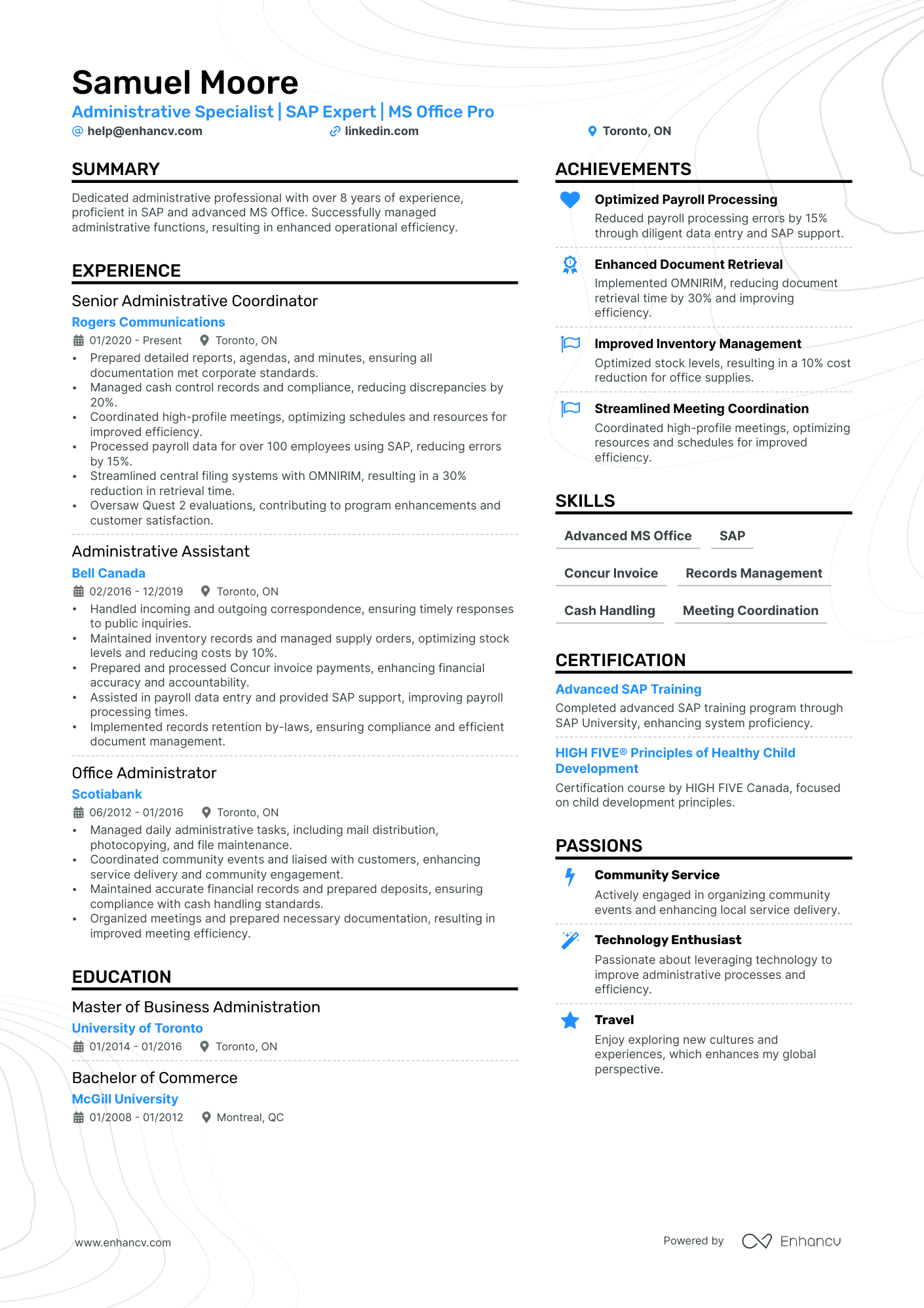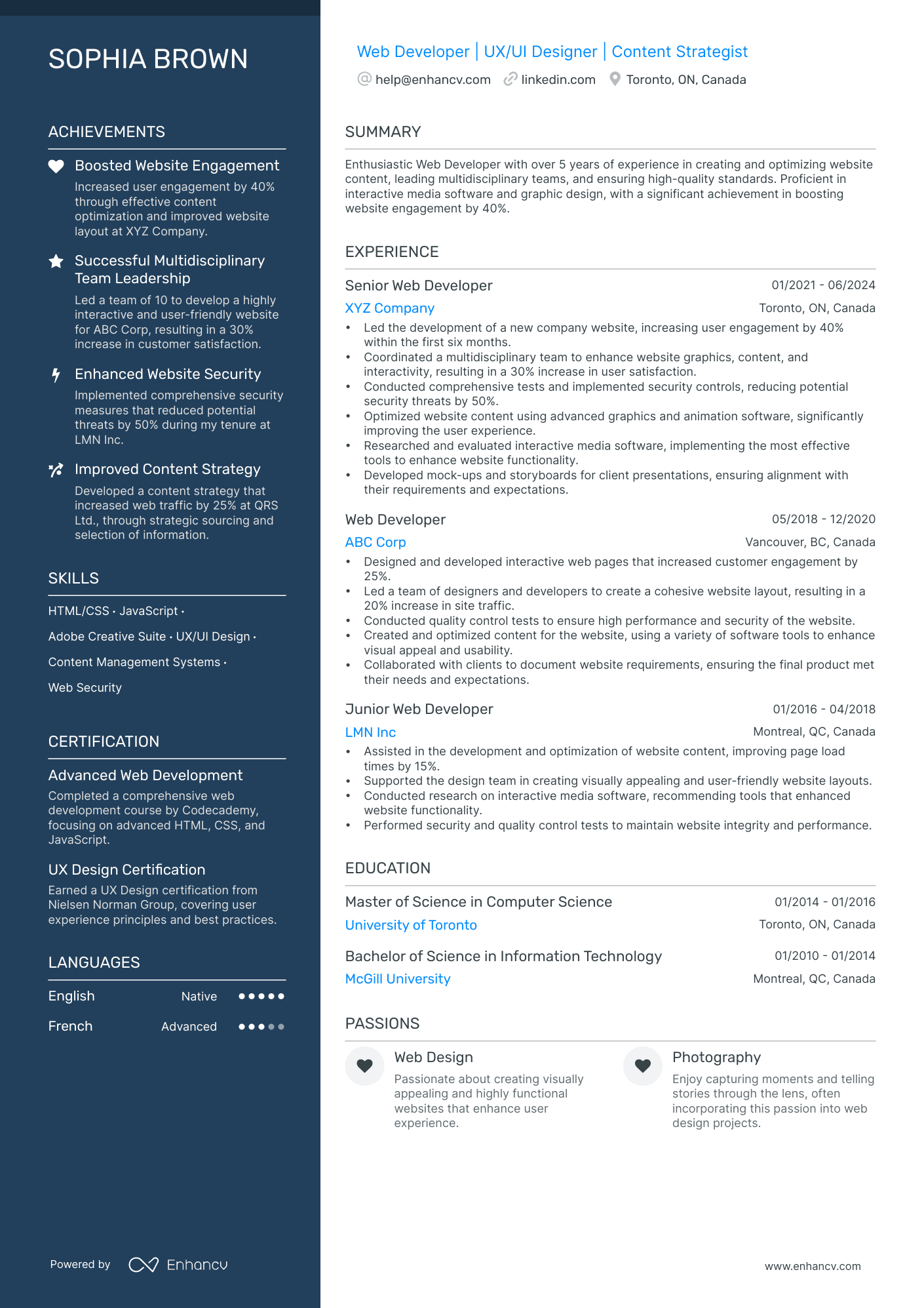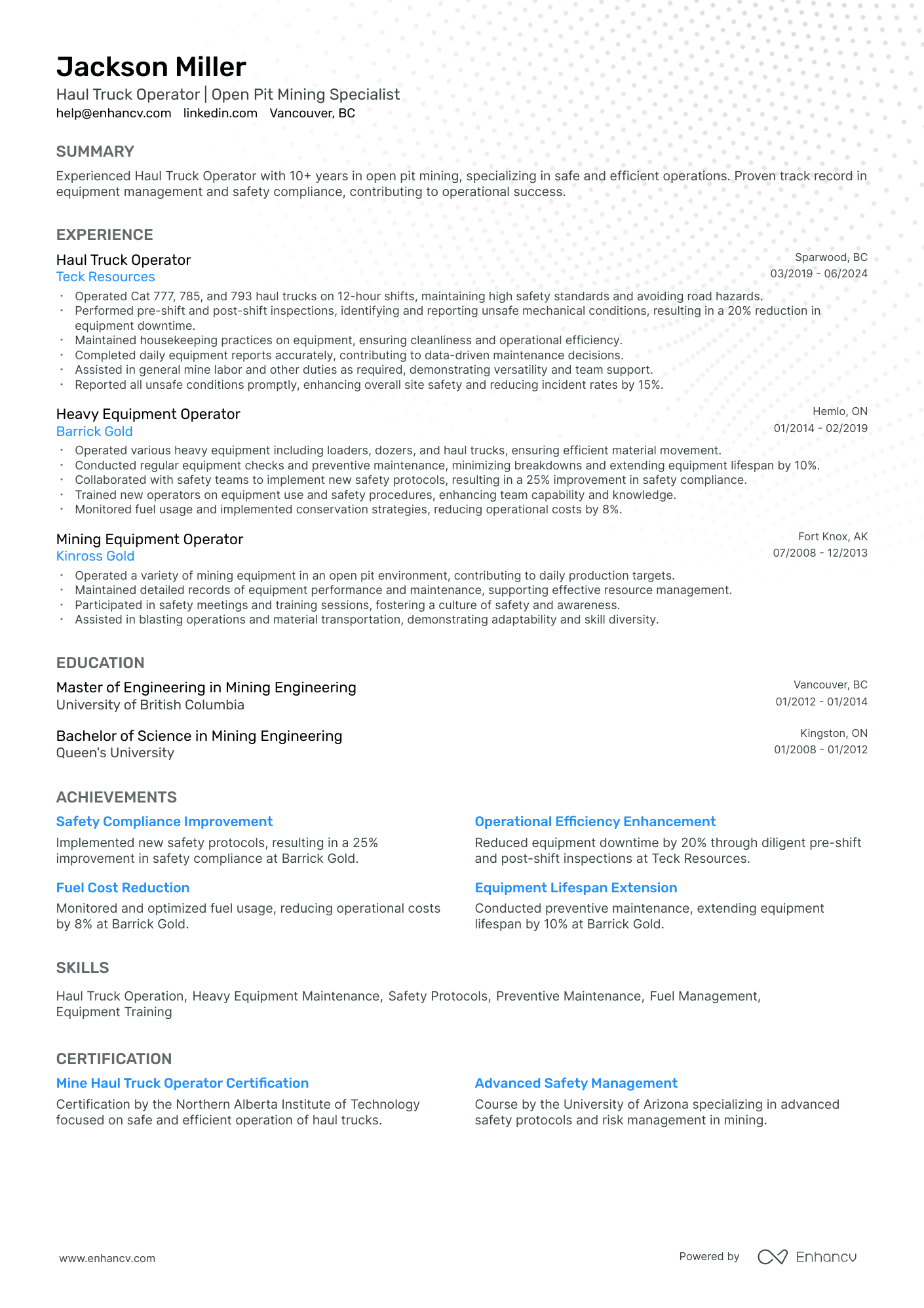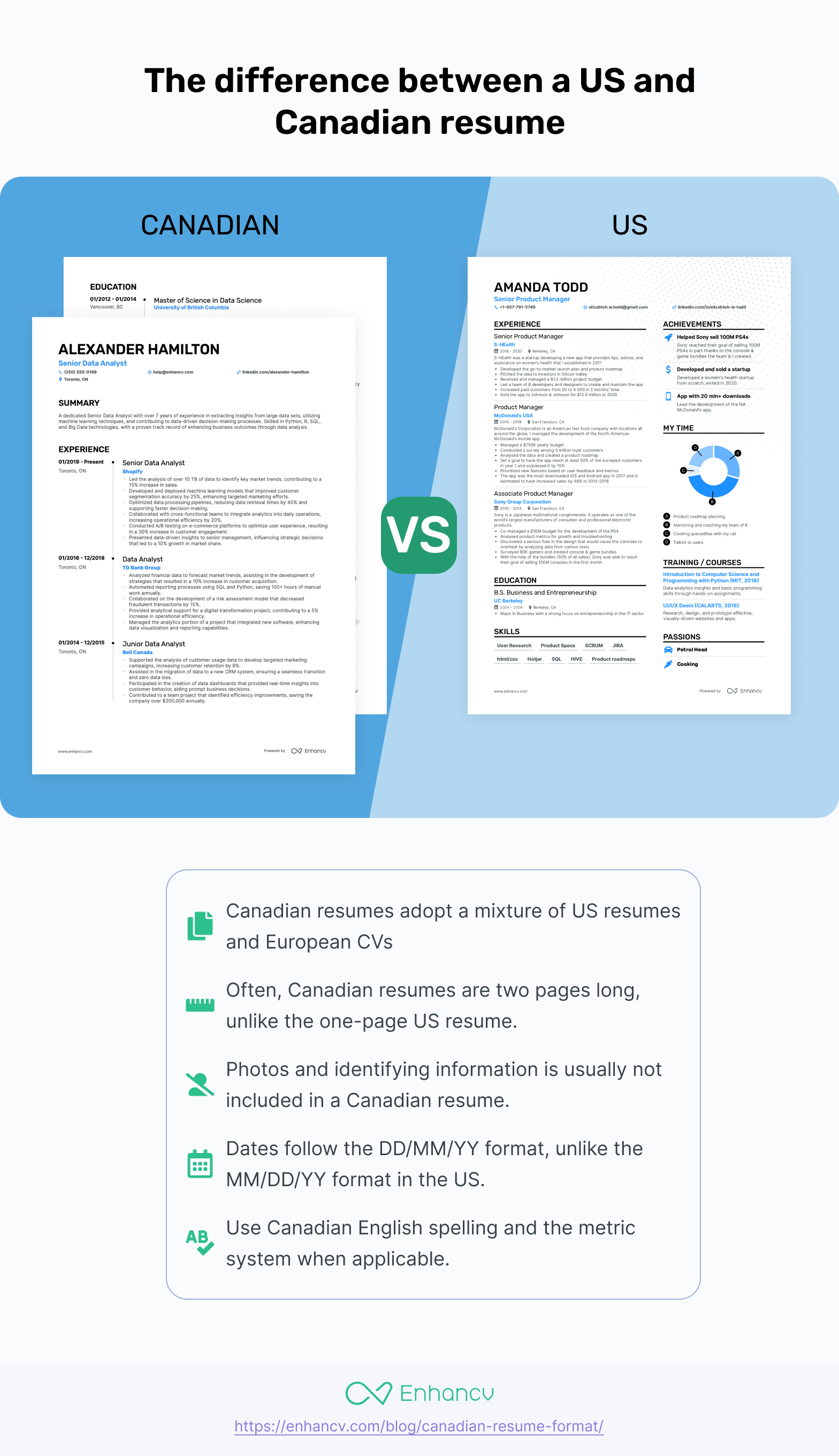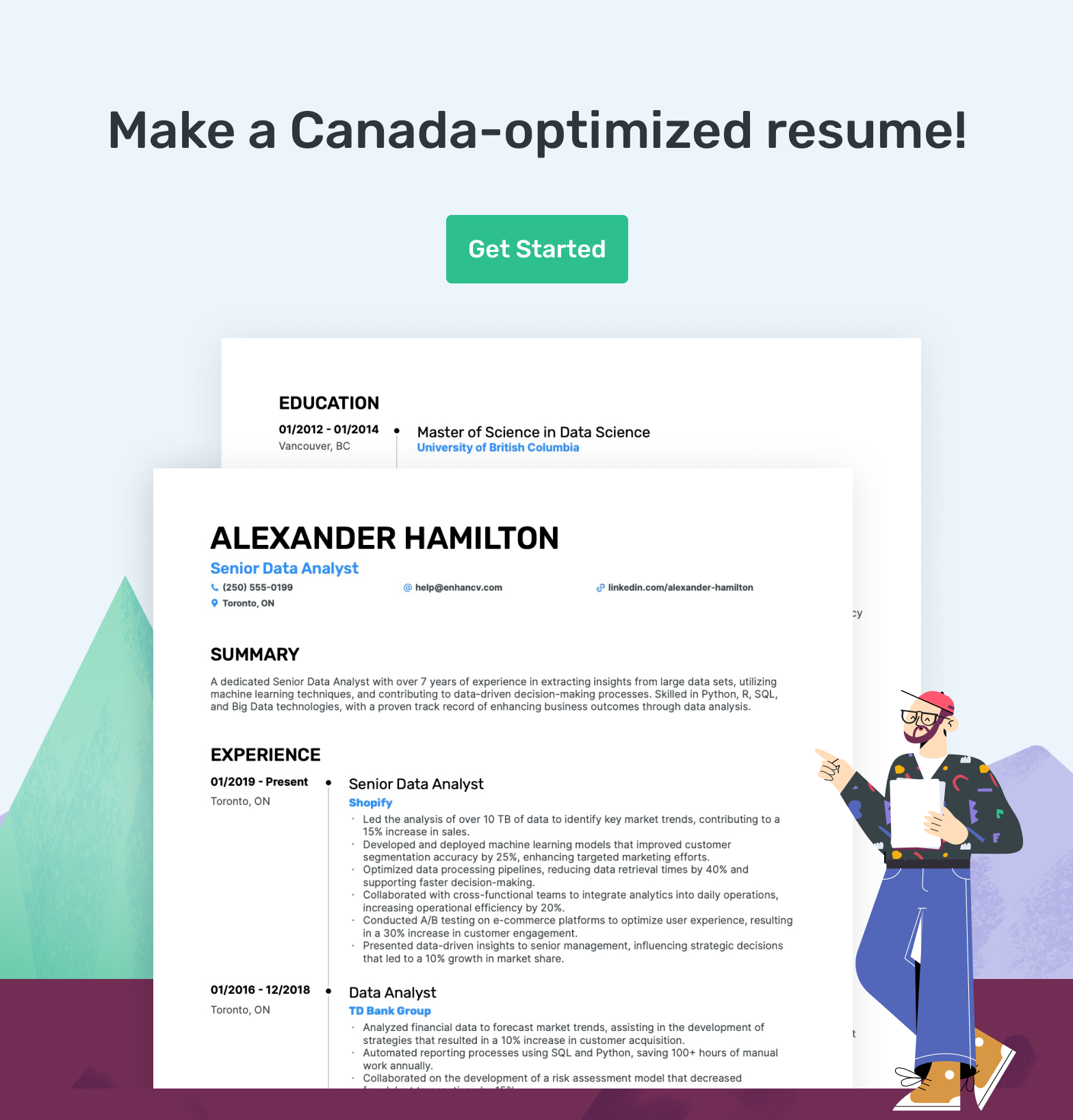Understanding the Canadian resume format is crucial whether you're applying for a job within the country for the first time, or you're a Canadian looking to refine your resume.
Canada plans to invite 1.45 million new permanent residents by 2025 to address labor shortages and an aging population. This move not only aims to strengthen the workforce and ensure immigrant skills meet job demands but also addresses challenges newcomers face in securing appropriate employment.
The country offers a unique blend of American and European characteristics, and this extends to its job application process, especially when it comes to resumes.
But how does a resume tailored for Canada differ from an American one? This guide provides all the details on what makes a Canadian resume unique, alongside practical advice and examples to help you craft a resume that could open doors to new opportunities in Canada.
Here's what we'll explore:
- The distinct features of Canadian resumes compared to American and European formats;
- A detailed guide on crafting your resume to meet Canadian standards;
- An exploration of frequently asked questions, providing thorough answers and insights;
- Advice for making your Canadian resume stand out to employers.
Plus much more! Let's begin!
Is your resume good enough?
Drop your resume here or choose a file. PDF & DOCX only. Max 2MB file size.
Canadian resume template
Enhancv’s Canadian resume template has been optimized to meet the demands of the Canadian resume format. It follows a chronological work experience section. Furthermore, it has no photo in the header, something that’s typically frowned upon in Canada.
Last but not least, Enhancv’s Canadian resume template supports a two-page resume format, which is one of the things that sets apart Canadian and US resumes.
Canadian resume examples for the most popular jobs
Registered nurse resume
Registered nurses are in particularly high demand across Canada due to the COVID-19 pandemic and an aging population. There are several immigration pathways available for nurses looking to work in Canada.
Software engineer resume
Software engineers are in high demand in Canada, especially in provinces like Alberta, Manitoba, Nova Scotia, Ontario, and Prince Edward Island. They earn an average annual salary of $127,379.03 CAD.
Administrative assistant resume
Administrative assistants are essential in keeping organizations running smoothly. They earn an average annual salary of $61,923.42 CAD, with high demand in provinces like Manitoba, Nova Scotia, and Yukon Territory.
Web developer resume
Web developers are in high demand in Canada's booming tech industry. The Global Talent Stream and various Provincial Nominee Programs provide pathways for web developers to obtain a Canada work permit.
Truck driver resume
Truck drivers are one of the most in-demand jobs in Canada, with a vacancy rate around 8%. They are needed across the country to transport commercial goods.
Other popular and in-demand jobs in Canada include electrical engineers, welders, veterinarians, licensed practical nurses, and accountants.
What is the Canadian resume format
The Canadian resume format is a structured approach to presenting your work history and skills relevant to the job you're applying for. It starts with a header section that contains your name, phone number, current location, and email address. If you have a LinkedIn profile, include the URL in your contact information.
Many Canadian employers use LinkedIn to research potential candidates. Following the header, you need to put either a summary or objective to give a snapshot of your career goals and strengths. Next, the resume should detail your work history, education, and skills. Personal details like marital status and photos are not included, allowing the focus to remain on your expertise.
What is the difference between a Canadian and an American (US) resume
Making a resume for Canada is similar to the United States but for a few important differences. Both countries use resumes more than CVs, and they usually look alike. Yet, spelling matters a lot in Canada. Though Canada uses English, it also embraces French, affecting some English spellings. To make sure your resume fits Canadian preferences, follow these tips:
- Use Canadian spellings, like "behaviour" and "neighbour," and prefer "theatre," "labour," and "defence."
- Apply the metric system for measurements, showing familiarity with Canada's standards if applicable. For example, if you worked in distribution, you could mention “leading a team that distributed goods across a 300-kilometer area."
- Write dates in the DD/MM/YYYY format, which is common in Canada.
- Include graphic designs in your resume only if you look for a job as a graphic designer. Typically, Canadians don't include these elements when applying for a new position.
- Employ the services of the Canadian Information Centre for International Credentials to understand the Canadian equivalence of your credentials. Taking this step can help push your job search forward, yet it doesn't secure a job offer.
These small but crucial adjustments show you're ready to work smoothly in Canada. They show your ability to adapt and pay attention to local details, which is appealing to Canadian employers.
What is the difference between a Canadian resume format and a European CV
The Canadian resume format and the European CV serve as key tools in job applications, but they follow different conventions that reflect the job market and cultural expectations of their respective regions. The Canadian resume format is streamlined and job-focused, typically extending to a maximum of two pages and emphasizing the candidate's most relevant experiences and skills for the specific position.
Moreover, in Canada, when we talk about a CV, we're referring to a very detailed document mostly used in academic settings, not for regular job applications. These CVs are pretty lengthy, going from two to ten pages, and they cover everything from your work history to your projects and any papers you've published.
European resumes, commonly called CVs in the Old Continent, tend to be more detailed compared to Canadian resumes. They include high school education and grades, regardless of higher educational achievements. This level of detail is unnecessary in Canada, where the focus shifts to post-secondary education and adequate work experience.
Another big difference is the inclusion of personal information. In some European countries, including a photo on your resume is common and often expected by employers.
Including photos on your resume is not endorsed in Canada. Personal details such as date of birth, nationality, or other information that could potentially lead to discrimination are omitted in Canadian resumes.
The goal is to ensure a fair evaluation process, focusing solely on professional qualifications and experiences.
How to write a Canadian resume — what to include
Believe it or not, the Canadian resume is pretty similar to an American. However while the format is similar, the devil is in the details.
When looking for a job in Canada, picking the right resume format is key because it really affects your chances of success. If you've been working for more than ten years, think about using a reverse chronological resume. This format lists your jobs from newest to oldest, making it easy to see how you've moved up in your career. It's a good way to show your experience in a clear way that employers like, especially in Canada.
In addition to the format, you also need to consider the template. It's important to choose a professionally designed resume template which can enhance the readability of your resume and create a positive first impression with hiring managers. After you've selected your template, the next step is organizing your Canadian resume.
Header
When creating your Canadian resume, start with a well-organized header that grabs attention. Include essential information like your name, job title, phone number, professional email, and LinkedIn link. Make sure your name matches what's on your professional records and online profiles to make it easy for recruiters to find you.
Moreover, it would be better to use a professional email provider like Gmail or Outlook. Mention the job you're applying for, not your current position, to align your resume with the job listing. Just listing your city is enough for the location, especially if you're applying for jobs in different places.
Finally, when you include links to your LinkedIn or portfolio, make sure they're up-to-date and match your resume.
In Canada, including a photo on your resume is typically reserved for roles where appearance is a job requirement, such as in modeling or acting. For other jobs, adding a photo can look odd and might worry some employers, so better not to include it to avoid misinterpretations.
Jackson Thompson's resume header is thoughtfully organized and offers quick access to his contact and professional information.
Resume summary
Following the header, the career summary section appears, offering a concise overview in no more than five sentences that show your key professional achievements. The professional summary focuses on your main strengths and skills related directly to the position's duties and responsibilities. After reading the information in this section, the recruiter has a better understanding of who you are and what skills and abilities you may bring to the position. Tailor this for every job application to address the company and the position's requirements.
Let’s see an example:
This example shows the applicant's strong expertise in marketing and track record of achievements. Also, it puts the focus on specific skills and growth metrics that are important for Canadian employers.
Work experience
When creating your work experience section list your previous jobs in reverse chronological order, starting with the most recent. Include the job title, company name, location, and dates of employment. Describe your responsibilities, achievements, and contributions using bullet points.
Here’s an example of the structure:
- Begin with the latest job and work backwards, but limit the history to the last 10 to 15 years. Older roles, like a college job, might not interest the hiring manager.
- Lead with the position title, which helps the recruiter assess if your experience aligns with the job requirements.
- Mention the employer's name and its location. For lesser-known companies, a short description might be helpful.
- State the period of employment using the DD/MM/YYYY format, which is concise and clear.
- Describe your responsibilities and accomplishments with 4-6 bullet points for recent roles and 2-3 for previous positions.
Check out the example:
- •Developed and executed a digital marketing strategy that resulted in a 30% increase in website traffic.
- •Managed social media accounts, growing the follower base by 25% in one year.
- •Coordinated with the sales team to create promotional materials that led to a 15% rise in sales.
- •Organized and directed market research studies to inform future marketing strategies.
- •Led a team in implementing innovative email marketing campaigns that boosted lead generation by 20%.
- •Spearheaded the redesign of the company website, improving user engagement metrics by 35%.
- •Established a content marketing plan that increased brand visibility and market penetration.
- •Optimized website content for major search engines, resulting in a top 5 ranking for key terms.
- •Analyzed web analytics to adjust SEO strategies and improve overall website performance.
- •Collaborated with the content creation team to ensure SEO best practices were consistently applied.
- •Assisted in the development and implementation of marketing strategies to enhance brand recognition.
- •Supported the organization of promotional events that led to increased customer engagement.
- •Conducted competitive analysis to inform the marketing team's strategy adjustments.
This example illustrates an effective way to organize your work history when listing multiple previous roles. It emphasizes the importance of conciseness while clearly detailing your responsibilities and successes.
Carefully read the job posting and identify the required qualifications and skills. Take note of particular keywords and phrases used throughout the description to tailor the resume for the specific role.
Education
The educational background is an essential part of your Canadian resume and it comes right after the work experience. Here is the place to mention the degree, diploma, and certifications earned, the name of the institution, the location, and the year of graduation. Begin with your most recent educational achievement and proceed in reverse chronological order, mirroring the format of your work history section. Don't forget to highlight any honors or academic distinctions you've received.
For your Canadian resume, consider specifying this information in the education section:
- State the degree you've earned as your degree title.
- Identify the institution where you received your education as your college or university.
- Include the location of your educational institution.
- Note the year of your graduation or the anticipated graduation year as your completion date.
- Mention a minor study, for instance, "Minor in Digital Media," to demonstrate a broader skill set within the marketing field.
- List any certificates you obtained related to your field of study.
Here's how this section can look:
- •Specialized Coursework: Advanced digital marketing strategies and data-driven marketing decisions
- •Graduated with Honors
- •Minor in Digital Media
- •Core Modules: Marketing principles, consumer behavior, and digital media strategy
This example demonstrates a structured approach to presenting your educational background. It shows how to effectively list degrees, institutions, and relevant coursework, ensuring that your qualifications are easily understood by recruiters in Canada.
PRO TIP
You may need to have your documents translated into English, French, or both.
It is generally advised to keep the education section simple, ensuring it doesn't overshadow your skills.
Skills
Highlight your key skills relevant to the job. This can include technical skills, software proficiency, language proficiency, and any other abilities that showcase your qualifications for the position.
Skills on your resume are categorized into:
- Soft skills refer to personal qualities and behaviors developed through both life and work experiences. These skills encompass communication, attention to detail, and problem-solving.
- Hard skills stand in contrast as the specific technical know-how or proficiencies gained through education, training endeavors, or direct experience. For instance, in the context of finance, include specialized expertise like advanced Excel functions for financial analysis, familiarity with QuickBooks for accounting tasks, and adeptness in using Bloomberg terminals for market research.
When curating your skills list, focus on those most relevant to the job at hand. For a front-end developer position, for instance, your proficiency in HTML, CSS, JavaScript, and frameworks such as React or Angular is more relevant than an unrelated skill like martial arts. Employers seek skills that make you an ideal fit for their specific needs, rather than a broad array of abilities.
To ensure your resume resonates with the job description, identify the employer's desired skills and make sure to include them in your Canada resume. Aim for a balanced presentation of both soft and hard skills tailored to meet the requirements of a front-end developer role.
The most in-demand hard skills in Canada for 2025 center around cybersecurity, data analytics, sustainability, remote work, and emerging technologies like generative AI. Employers are seeking candidates with specialized technical expertise in these areas.
And for soft skills, employers look for communication, adaptability, collaboration, critical thinking, and digital literacy. Overall, employers are looking for well-rounded professionals who can navigate the evolving job market and contribute effectively to their organizations.
Here’s how you might approach it:
Languages
When we talk about resume creation, language skills are more than just a mark of education. They're a bridge to diverse cultures and markets, making them vital in the Canadian job market. Adding languages to your Canadian resume shows your ability to communicate across different cultures.
In Canada, where English and French are widely spoken, being bilingual can significantly boost your job prospects. Including languages on your resume, along with your proficiency levels, signals to employers your capacity to adapt and connect in a multicultural setting. This section is crucial, distinguishing you as a candidate well-suited for the dynamic Canadian work culture.
Languages and additional courses both play a crucial role in enhancing your professional profile, so let's see how to present them properly in your Canadian resume.
Courses
This is an ideal moment to demonstrate your passion for learning. Include any relevant training, courses, or seminars to underscore your dedication to ongoing professional growth. It signals to employers your commitment to staying updated with industry trends and techniques, enhancing your appeal as a candidate.
Such educational achievements can be especially crucial in fast-changing sectors, evidencing your readiness to tackle contemporary challenges.
Start with your newest qualifications and list them in time order, similar to how you list job experience and education.
Let's go back to our example of Jackson Thompson, the Marketing Specialist, and check what courses would be relevant for him.
Is your resume good enough?
Drop your resume here or choose a file. PDF & DOCX only. Max 2MB file size.
Getting a job in Canada as an immigrant
Securing a job in Canada as an immigrant is a significant step toward starting a new life. The process involves understanding eligibility criteria, choosing the right immigration pathway, preparing necessary documents, and planning for settlement. Here’s a comprehensive guide to help you through this journey.
First, determine your eligibility. Ensure you have at least a senior secondary education, a minimum of one year of relevant work experience, and proficiency in English or French, depending on where you plan to settle. You also need to meet the minimum points requirement on the Comprehensive Ranking System (CRS) for programs like the Federal Skilled Worker Program (FSWP), Federal Skilled Trades Program (FSTP), or Canadian Experience Class (CEC).
Next, choose your immigration pathway. The Express Entry system offers various programs. The FSWP is ideal for skilled workers with specific qualifications, while the FSTP caters to tradespersons with Canadian job offers or valid certificate qualifications. The CEC is designed for those with at least three years of Canadian work experience. Alternatively, Provincial Nominee Programs (PNPs) offer a more accessible route and can integrate with the Express Entry system. If you have a family member who can sponsor your migration, family sponsorship might be an option. Business Immigration Programs are also available for investors, entrepreneurs, and self-employed persons looking to contribute to Canada’s economy.
Once you have chosen your pathway, prepare your application by creating an online Express Entry profile and uploading your qualifications. Gather all required documents, including proof of language proficiency (such as IELTS or TEF), education (degrees, diplomas), work experience (letters, certificates), and other necessary documents like a clean criminal record and proof of settlement funds.
After submitting your application, you will need to wait for an invitation to apply (ITA). For Express Entry, ITAs are sent to the highest-scoring candidates. For PNPs, you will need to wait for a nomination from the province. Once you receive an ITA or provincial nomination, submit your application for permanent residency (PR). The approval process typically takes about six months for both Express Entry and PNPs.
As you prepare for settlement, ensure you have the required settlement funds—at least CAD$13,757 for a single applicant under Express Entry, and the necessary amount for your family size under PNPs. Plan your move by arranging housing, starting your job search in your field, and considering further language training to improve proficiency.
By following these steps, you can increase your chances of successfully securing a job in Canada as an immigrant. Thorough preparation will ensure a smoother transition and help you integrate into your new life in Canada.
FAQ about Canadian resumes
This part of our guide is your go-to resource for addressing frequently asked questions about crafting resumes for the Canadian job market. Learn how to create cover letters, tips for international applicants, and whether to choose PDF or.docx. Let's begin with the very first topic.
How do I navigate the Canadian job market as a foreigner?
Navigating the Canadian job market as a foreigner can certainly be a challenge, but with the right approach, it's definitely manageable. Here's your compass and map to find your way through.
Let's go forth with precise tips.
- Identify the industry you’re educated in and make your resume resonate with Canadian employers by thoroughly researching the Canadian job market.
- Start building your network by participating in career fairs, making connections at professional events, and creating a solid LinkedIn profile to showcase your skills.
- Take on freelance opportunities to gain valuable Canadian experience and integrate yourself into the local professional community.
- Utilize resources such as the Canadian government’s Job Bank and immigrant-serving organizations to find valuable assistance in your job search.
- Demonstrate your readiness to thrive in Canada's diverse workplace by emphasizing your cultural awareness and language skills in English or French.
- Boost your qualifications by taking courses or getting certifications from well-known institutions or companies in your area. If we go back to our example for the Marketing Specialist Jackson Thompson, he should focus on acquiring certifications from renowned companies such as Google and Microsoft as these certifications are globally recognized and respected and would serve as a testament to an overseas candidate's skills and knowledge.
- Tailor your resume with each job description and adapt your application to meet specific employer preferences, including Canadian spelling nuances. Remember, precision, like opting for 'colour' over 'color', demonstrates attention to detail.
- Keep a steady pace and stay resilient in your job search in Canada, and know that finding the right opportunity might take time but your efforts will eventually pay off.
Do I need a cover letter to pair with my resume when applying for a job in Canada?
It's a good idea to include a cover letter with your resume. A cover letter lets you detail how your skills match the job and the company's needs. It helps you make a strong first impression and gives you space not only to demonstrate your enthusiasm about the position but also to present yourself professionally.
Here's some practical advice for your cover letter:
- Ensure your header aligns with your resume by listing your name, surname, job title, Canadian phone number, and professional email. You can also add a LinkedIn profile or personal website to make your application more engaging.
- Address the cover letter properly in your greeting line, using 'Dear [Name]' or 'Dear Mr./Ms. [Surname].' If the name of the hiring manager is unknown, 'Dear [Department] Team' works well. This personal touch shows effort and interest.
- Start your cover letter with a powerful opening sentence that highlights your achievements or unique skills, capturing the hiring manager's attention and setting you apart from other applicants.
- In the body of your cover letter, go beyond your resume to tell a compelling story about your skills and experiences. Showcase how you can contribute to the company's success with examples of leadership, communication, and problem-solving abilities.
- Conclude with a closing paragraph that encourages further dialogue, ensuring you include your signature line.
Open the door to your new job in Canada with our professionally designed cover letter templates. Use our intuitive cover letter builder to make your own for free.
Should I save my Canadian resume as a .docx or a .pdf file?
The PDF format is highly recommended due to its consistent appearance on various devices and operating systems. It preserves your document's design and visuals and eliminates the risk of unintended edits by the recipient.
Job platforms in Canada commonly accept both PDF and Word documents. However, unless specified otherwise in the job posting, opting to submit your resume as a PDF is advisable for preserving its intended presentation.
PRO TIP
Include your full name in your document filename to make it memorable (i.e. Jackson-Thompson-Resume.pdf)
Do Canadians say “CV” or “Resume”?
In Canada, the terms "resume" and "CV" (Curriculum Vitae) are both used, but they have different meanings. A resume is usually one or two pages long and shows your skills and experience related to the job you want. It's meant to be quick to read and match the job description. Canadian employers prefer this direct and brief way of showing your capabilities.
On the other hand, a CV is much more detailed and covers your whole career, including education, publications, research, and big achievements. It's mainly used in fields like academia, science, and medicine, where showing the full scope of your work matters a lot. CVs are longer than resumes and can be much more than two pages, based on how much you've done in your career.
What NOT to include in my Canadian resume?
In Canada, your cover letter and resume should not contain personal details such as marital status, religion, gender, age, or sexual orientation. Additionally, unless you're seeking a role in modeling or acting, photos are unnecessary. Including such information not only wastes precious space but could also lead employers to bypass your application to avoid potential discrimination claims. It's worth noting that Canadian law prohibits employers from requesting information regarding your sexual orientation, age, or ethnicity during the application process or interviews. To prevent placing recruiters or employers in a difficult position, it's advisable to exclude these details.
Furthermore, mentioning salary expectations or irrelevant personal interests is considered inappropriate.
Key takeaways
- Canada's plan to welcome 1.45 million new residents by 2025 underscores the need for job applicants to craft resumes tailored to specific employer requirements and Canadian English standards.
- In Canada, a resume is concise and job-focused, unlike CVs, which are detailed for academic roles, differing from European CVs that include personal information.
- Adapting your resume for Canada involves using local spellings, the metric system, and specific date formats to meet employer preferences and show an understanding of local culture.
- Choosing the chronological resume format is crucial, along with selecting a professional template for a good first impression.
- Begin your resume with a detailed header and a summary that shows your excellent results from previous jobs and skills relevant to the job you're applying for.
- Including a cover letter with your resume is strongly advised, as it provides an opportunity to demonstrate your enthusiasm and willingness to contribute to the new workplace.
How we wrote and reviewed this article
The team at Enhancv tries to provide the most up-to-date and accurate information — we often use a mix of internal data and external sources to create a cohesive, detailed picture of the topic at hand.
For this guide on canadian resumes we referred to our career coaching team where they provided key insights from working with canadian clients — most sought after skills, the difference between a canadian resume style and the US resume. We also used news reports and statistics to form our opinion and advice:
- Employment and unemployment statistics in Canada (Statistics Canada)
- Resume writing tips for international students in Canada (Arrive)
- Transitioning to the Canadian job market (Moving 2 Canada)
- Working in Canada as an international student (Canada.ca)
- An Often Overlooked Jobs Indicator Points to Deep Cracks in Canada’s Labor Market (Bloomberg)
Make one that's truly you.

